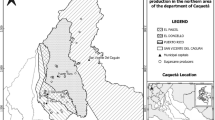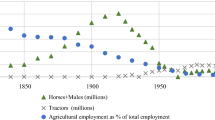Abstract
Ethiopia is well-endowed with bamboo resources that have important economic, social, and ecological roles. Nevertheless, its contribution to producer’s livelihoods and the national economy is very low compared to its potential. This study evaluates the financial performance of bamboo plantations against agricultural crops, Acacia decurrens plantations, and eucalyptus plantations in Banja district. Primary data were collected from 139 households and financial analysis was used to assess the profitability of the systems. The findings revealed that all land-use systems show positive values for all financial indicators. Comparatively, bamboo plantations are the second highly profitable land-use system next to Eucalyptus plantations with NPV of ETB 276,830.50 and BCR of 9, which is twice as high as crop production in the study area. However, the land allocation made by smallholder farmer for bamboo plantation was relatively smaller than other land use systems. Consequently, the current contribution of bamboo falls short of the contribution expected from the sector. Smallholder farmers in the area still rely on crop production though they are not satisfied with its return and it is sensitive to weather variability and is characterized by inherent low productivity. Hence, there is a need for a reform of the existing agricultural extension policy of the nation that has been biased to agronomic crops and it needs to be modified in a way that it is inclusive of alternative land uses on the basis of their financial profitability, social preferences and environmental resilience.


Similar content being viewed by others
Notes
ETB = Ethiopian Birr = 0.0336 USD as of December 2018.
Population data have taken from the 2017 report of Banja district agricultural and rural development office.
References
Adenew B, Statz J (2007) Bamboo market study in Ethiopia: Prepared for the United Nations Industrial Development. Organization Acting as executing agency for the Common Fund for Commodities. UNIDO
Assaye Y, Gebreselalssie Y, Ayele B (2014) Farmer’s perception on highland bamboo (Yushina alpina) for land resource conservation in Banja district. Wudpeker J Agric Res 3(1):001–009
Bakala F, Bekele T, Woldeamanuel T (2017) Market supply determinants of lowland bamboo culms: The case of Homsha district. Northwestern Ethiopia 9(4):46–58
Bessie S, Beyene F, Hundie B, Goshu D, Mulatu Y (2016) Land use/land cover change and its effects on bamboo forest in Benishangul Gumuz region, Ethiopia. Int J Sustain Dev World Policy 5(1):1–11
CRGE (2011) Ethiopia’s Climate Resilience Green Economy strategy. Addis Ababa, Ethiopia
CSA (2012) Agricultural Sample Survey. Report on Land Utilization. Statistical Bulletin 532. Addis Ababa, Ethiopia
CSA (2013) Ethiopia Rural Socioeconomic Survey (ERSS) 2013 Survey report. Addis Ababa, Ethiopia
Dessalegn G, Tadesse W (2014) Resource communication. Resource potential of bamboo, challenges and future directions towards sustainable management and utilization and development in Ethiopia. Instituto Nacional de Investigacion y Technologia Agrariya y Alimentaria 23(2):294–295
Embaye K (2000) The indigenous bamboo forests of Ethiopia: An overview. AMBIO: A J Human Environ 29(8):518–521
Embaye K (2003) Ecological aspects and resource management of bamboo forests in Ethiopia. Doctoral dissertation. Swedish University of Agricultural Science (SLU), Uppsala, Sweden.
Endalemaw TB, André L, Jürgen P (2013) Indicators and Determinants of Small-Scale Bamboo Commercialization in Ethiopia. Forests 4(3):710–729
Ghimire A (2008) An Assessment of the Dependency of Farmers on Bamboo Resource for Rural Livelihood in Lalitpur District, Nepal. Master Thesis. Vienna, Austria
Gittinger JP (1984) Economic analysis of agricultural project. The John Hopkins University Press, Baltimore
Hergert HJ (1991) Economic evaluation of a pole and fuel wood production project in the Harerge Highland, eastern Ethiopia. Economics in developing countries I. Acta Horticulture 270
INBAR (2014) From Research to Development: Overview of new strategic approaches and results. International Network for Bamboo and Rattan. ISBN: 978-92-95098-63-3 (printed). China, Beijing
INBAR (2018) Remote sensing based regional bamboo resource assessment report of Ethiopia, Kenya and Uganda. International Bamboo and Rattan Organisation, Beijing
INBAR (2020) Bamboo policy integration analysis, Ethiopia. INBAR working paper No. 84. Addis Ababa, Ethiopia
IPCC (2012) Managing the risks of extreme events and disasters to advance climate change adaptation. Cambridge University Press, Cambridge
Jalota RK, Sangha KK (2000) Comparative ecological-economic analysis of growth performance of exotic Eucalyptus tereticornis and indigenous Dalbergia sissoo in mono-culture plantations. Ecol Econ 33(3):487–495
Kadariah LK, Gray C (1999) Introduction of project evaluation. Publisher Institute Faculty of Economics, University of Indonesia, Jakarta
Kassa G (2014) Profitability analysis and determinants of fruit tree based agroforestry system in Wondo District, Ethiopia. African J Agric Res 10(11):1273–1280
Kebebew Z (2002) Profitability and household income contribution of growing Eucalyptus globules (Labill.) to smallholder farmers: the case of central highlands of Oromia, Ethiopia. Master’s Thesis. SLU, Sweden
Kelbessa E, Bekele T, Gebrehiwot A, Hadera G (2000) A socioeconomic case study of bamboo sector in Ethiopia: An analysis of the production-to-consumption system. Addis Ababa, Ethiopia
Kidanu S, Ayele G (2004) Farm practices and economics of Eucalyptus globules boundary plantings on highland Vertisols in Ethiopia. In Tropical Resource Management Papers, No. 52 (pp. 69-89)
Kindu M, Glatzel G, Tadesse Y, Yosef A (2006) Tree species screened on Nitosols of central Ethiopia: biomass production, nutrient contents and effect on soil nitrogen. J Tropic Forest Sci 18(3):173–180
Kristina LC, Juan IA (2013) Specialization of bamboo by Neotropical Birds. J Cooper Ornithologic Soc 115(2):217–220
LUSO Consult (1997) Study on sustainable bamboo management. Final Report on behalf of Deutsche Gesellschaftfür Technische Zusammenarbeit. GTZ) GmbH, Eschborn, Hamburg
Mekonnen A, Fashing PJ, Bekele A, Hernandez-Aguilar RA, Rueness EK, Nguyen, Stenseth NC (2017) Impacts of habitat loss and fragmentation on the activity budget, ranging ecology and habitat use monkeys (Chlorocebus djamdjamensis) in the southern Ethiopian highlands. Am. J. Primotal
Mekonnen Z (2010) Community Opinion, Marketing and Current Debates on Eucalyptus in Huruta District, Arsi Zone of Oromia Region, Ethiopia. In Proceedings From the Congress
Mekonnen Z (2013) Productivity of Eucalyptus camaldulensis (Dehnh.) in GoroWoreda of Bale Zone, Etiopia. Res J Agric Environ 2(9):252–260
Mekonnen Z, Kassa H, Lemenih M, Campbell B (2007) The role and management of Eucalyptus in Lode Hotesa districts. Central EthiopiaForest Trees Livelihoods 17(4):309–323
Mekonnen Z, Worku A, Yohannes T, Alebachew M, Kassa H (2014) Bamboo Resources in Ethiopia: Their value chain and contribution to livelihoods. Ethnobotany Res Appl 12:511–524
Mesfin D (2002) Economic analysis of Eucalyptus globules plantation in the former Dessie Fuel wood Project, South Wollo, Ethiopia. Master Thesis. SLU, Sweden
MoFED (2010) Growth and Transformation Plan (GTP), 2010/11-2014/15. Addis Ababa, Ethiopia
MoEFCC (2017) Ethiopia’s forest sector review: Focus on commercial forestry and industrialization. Technical Report. Available at: https://mefcc.gov.et/ethiopia-forest-sector-review/ (Accessed: 16 October, 2019)
Mugenda OM, Mugenda A (2003) Research methods: qualitative and quantitative approaches. Africa center for technology studies, Nairobi, Kenya
Mulatu Y, Kindu M (2010) Status of Bamboo Resources Development, Utilization and Research in Ethiopia. Ethiopia Journal of Natural Resources.1 (2010), pp.79-98
Nune S, Kassie M, Mungatana E (2010) Forestry resource accounting: the experience of Ethiopia. CEEPA Discussion Paper No. 47. University of Pretoria, Centre for Environmental Economics and Policy in Africa (CEEPA)
Regio DG (2008) Guide to Cost-Benefit Analysis of investment projects. Structural Funds, Cohesion Fund and Instrument for Pre-Accession. European Commission. Directorate General Regional Policy
Schroder S (2012) Guada bamboo Vs Teak plantation. Guada bamboo. [Online]. Available from http://www.guaduabamboo.com/guadua/guadua-bamboo-vs-teak-plantations [Accessed: 2nd Nov. 16, 2018]
Sertse D, Disasa T, Bekele K, Alebachew M, Kebede Y, Eshete N, Eshetu S (2011) Mass flowering and death of bamboo: a potential threat to biodiversity and livelihoods in Ethiopia. J Biodiv Environ Sci 1(5):16–25
Tesfaye Y, Roos A, Campbell BM, Bohlin F (2011) Livelihood strategies and the role of forest income in participatory-managed forests of Dodola area in the bale highlands, southern Ethiopia. Forest policy economics 13(4):258–265
Teshale T, Woldeamanuel T, Bekele T, Alemu A, Pretzsch J (2017) Market channels for Highland Bamboo poles originated from Hula district. Sidama Zone, Southern Ethiopia
Teshome M (2004) The economics of growing E. globulus on farmer’s woodlot: the case of Kutaber District, South Wollo, Ethiopia. Wondo Genet College of Forestry. MSc thesis Report No. 94
Worku A, Lemenih M, Fetene M, Teketay D (2011) Socio-economic importance of gum and resin resources in the dry woodlands of Borana, Southern Ethiopia. Forest Trees Livelihoods 20(2–3):137–156
Yemishaw Y, Teketay D, Worku A, Yohannes Y (2009) Gathering storm: The fate of forestry research and development in Ethiopia. pp. 11-38 in proceeding of Forestry at Cross Road in Ethiopia: The way forward. Edited by Nigusu Aklilu. Hilton Hotel, 21-23 March, Addis Ababa, Ethiopia
Yiping L, Yanxia L, Buckingham K, Henley G, Guomo Z (2012) Bamboo and climate change mitigation: Executive summary. International Network for Bamboo and Rattan (INBAR), Technical report. No.32
Zhao Y, Feng D, Jayaraman D, Belay D, Sebrala H, Ngugi J, Maina E, Akombo R, Otuoma J, Mutyaba J, Kissa S, Qi S, Assefa F, Oduor NM, Ndawla KM, Li Y, Gong P (2018) ‘Bamboo mapping of Ethiopia, Kenya and Uganda for the year 2016 using multi-temporal Landsat imagery’. Int J Appl Earth Obs Geoinf 66:116–125
Acknowledgements
Financial support for this study was obtained from Ethiopian Environment and Forest Research Institute (Grant Number: +251 116 46 46 06). We are very grateful for all the farmers and experts who are willingly participated during the entire field work.
Author information
Authors and Affiliations
Corresponding author
Additional information
Publisher’s Note
Springer Nature remains neutral with regard to jurisdictional claims in published maps and institutional affiliations.
Rights and permissions
About this article
Cite this article
Siyoum, M., Woldeamanuel, T. & Eshete, A. Financial Analysis of Highland Bamboo Plantation: A Comparative Analysis with Other Land-use Systems in Ethiopia. Small-scale Forestry 21, 169–183 (2022). https://doi.org/10.1007/s11842-021-09493-6
Accepted:
Published:
Issue Date:
DOI: https://doi.org/10.1007/s11842-021-09493-6




